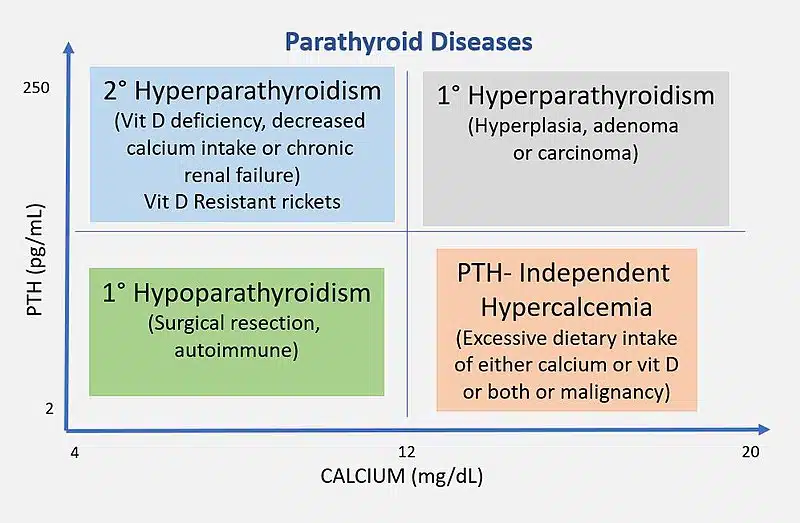Hyperparathyroidism and Cancer: What Is The Connection

Though often undiagnosed, it is estimated to affect 1 in 80 people and is much more common in postmenopausal women.
HPT can cause a range of uncomfortable symptoms and slowly damage the body in a number of ways. On top of that, HPT has been connected to an increased risk of several types of cancers.
So yes, hyperparathyroidism is something we should all know more about.
In my article, I’ll provide an overview of hyperparathyroidism and discuss the current research on the connection between HPT and cancer.
Introducing the Parathyroid
The thyroid is a powerful butterfly-shaped gland that sits in the front of the neck and regulates thyroid hormones throughout the body.
Tucked behind the thyroid are four pea-shaped glands called the parathyroid.
Together, these four glands produce parathyroid hormone (PT) and regulate levels of calcium and phosphorus in the blood.
Think of the parathyroid as a “calcium thermostat” for the body. If blood calcium levels go down, the parathyroid will release more PT.
If blood calcium levels are high, the glands will shut off the PT tap.
Most people know that proper calcium levels play a big role in helping to maintain bone health, but calcium also supports healthy nerve and muscle function as well.
So if the parathyroid starts malfunctioning or operating outside normal parameters, it can create a cascade of negative symptoms.
Why Is Hyperparathyroidism?
One of the most common diseases of the parathyroid is hyperparathyroidism.
HPT occurs when the abnormal parathyroid sends high levels of parathyroid hormone into the bloodstream, causing bones to release calcium into the blood thus leading to a rise in calcium levels.
Over time, high levels of calcium in the blood can damage organs and tissues throughout the body, as well as causing bone loss and osteoporosis.
Symptoms of HPT include:
- Severe bone weakness
- Kidney stones
- Fatigue
- Depression
- Brain fog,
- Joint pain
- Nausea and vomiting,
- Stomach pain
Primary Hyperparathyroidism (PHPT)
There are two types of HPT. The most common version of the disease is primary hyperparathyroidism (PHPT), which is caused by an enlargement of one or more parathyroid glands.
This is often the result of a tumor on one or more glands.
Secondary Hyperparathyroidism (SHPT)
This rarer form of HPT is often a secondary result of another disease that causes PTH levels to rise.
Secondary HPT can develop as a result of the parathyroid overcompensating to try and increase calcium levels in the body.
Health issues such as kidney disease, calcium deficiency malabsorption, magnesium deficiency, or vitamin D deficiency can trigger secondary HPT.
Diagnosing HPT
The symptoms of HPT can appear gradually, so many people with HPT don’t even know they have the condition.
It may first show up in the form of elevated calcium levels on a blood test. A doctor may then perform a sestamibi scan of the parathyroid glands.
Additional tests can check the urine’s bone density, vitamin D, and calcium levels.
Treatment
Secondary HPT can be treated by managing the underlying problem that is affecting the parathyroid glands.
Treatments for Primary HPT may vary depending on the level of symptoms a patient expresses.
If a patient isn’t experiencing negative symptoms, doesn’t have kidney malfunction or bone loss (osteopenia/osteoporosis) and only shows slightly elevated levels of blood calcium, a doctor may choose to monitor the condition.
In more severe cases, the most recommended treatment is surgery to remove the enlarged gland or glands.
According to the Cleveland Clinic, surgery performed by an experienced surgeon can cure hyperparathyroidism in roughly 95% of cases, or more.
Though many cases of HPT are mild, patients with HPT should be aware of the research that finds a connection between HPT and higher risk levels for certain types of cancer.
The Connection Between Hyperparathyroidism and Cancer
What exactly is the connection between HPT and cancer? Let’s look more specifically at parathyroid cancer, thyroid cancer, and a few other notable types of cancer.
HPT and Parathyroid Cancer
As mentioned earlier, a leading cause of primary hyperparathyroidism is a tumor on a parathyroid gland (or multiple glands).
According to Dr. Babak Larian, a leading surgeon at the CENTER for Advanced Parathyroid Surgery, the vast majority of parathyroid tumors are benign.
However, less than 1% of these tumors are malignant (meaning cancerous).
It isn’t exactly clear why certain people develop malignant tumors on their parathyroid, and others don’t.
Risk factors include receiving radiation therapy in the neck or head region and a family history of parathyroid cancer.
The best-known treatment for parathyroid cancer is a comprehensive removal of the affected parathyroid gland and the surrounding tissue.
The uncomfortable truth is that many symptoms of parathyroid cancer mimic hyperparathyroidism, since this type of cancer will also increase blood calcium levels just like HPT.
Anyone with HPT symptoms may want to discuss with their doctor whether a referral to a board-certified surgeon that treats hyperparathyroidism is a good idea.
HPT and Thyroid Cancer
Since the parathyroid and thyroid are located so close together in the body, it isn’t surprising that HPT may also affect the functionality of the thyroid.
In fact, a 2015 study looked at a small number of patients with PHPT and discovered that they had a higher rate of thyroid cancer than the general population.
The findings suggest a connection between PHPT and the incidence of thyroid cancer.
The study’s authors suggest that patients diagnosed with PHPT should be considered to be at a higher risk of thyroid cancer.
However, it’s not clear whether the higher incidence of thyroid cancer is a real connection or because patients with HPT invariably have their thyroid gland scanned and examined more than others.
HPT and Other Forms of Cancer
Unfortunately, parathyroid and thyroid cancers aren’t the only malignancies connected to HPT. A long-ranging study out of Sweden followed nearly 10,000 people with PHPT for up to 40 years.
Researchers found that patients with PHPT were at a higher risk of cancer compared to the general population, even 15 years after removing their parathyroid tumours.
Specifically, women were at a higher risk for breast cancer, while all patients faced an increased risk of kidney, colon, and a type of skin cancer.
Patients who had their parathyroid gland(s) removed before age 40 experienced an increased risk of endocrine and pancreatic cancer.
What Is the Connection Between HPT and Cancer?
Currently, it’s unclear why HPT seems to increase a person’s risk of so many different types of cancers.
Perhaps it has to do with the stress and damage caused by hypercalcemia (the increase of calcium in the bloodstream).
We know that hypercalcemia can slowly break down tissues and organs throughout the body.
What is clear is that hyperparathyroidism could use more research, understanding, and overall awareness.
Anyone with symptoms should see a specialist as soon as possible. The earlier HPT is diagnosed and treated, the less damage it can do.





